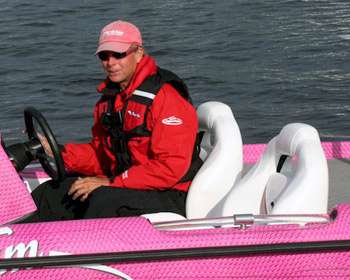
Burned into the mind of every bass angler are memorable days on the water when the surface suddenly erupted as wolf packs of bass viciously attacked schooling baitfish. In a sport where the target is generally unseen, the appearance of schooling bass on top usually generates a sudden adrenaline rush. Mayhem ensues as anglers franticly try to reach the school.
Then, just as suddenly as it appeared, the school is gone. While fishing for schooling bass can lead to some of the most exciting and action packed days on the water, it can also be extremely frustrating when you can see the bass feeding but can't get them to bite. Elite Series pro Kevin Short has a few tricks for keeping schooling bass active and putting more fish in the boat.
"True schooling fish, most of the times that I've seen them, are in little pods consisting of three to four bass," explains Short. "It's a little bit different than a school of deeper fish. When you hook a bass in a deep-water school, you might have 10 other bass following up that hooked fish.
However, when you find pods of bass schooling on top, you can rotate between pods and catch one or two out of each group." The Arkansas pro believes in the popular theory of 'matching the hatch' when it comes to maximizing the number of bass caught out of an active school. In schools of baitfish, individual fish might vary in size, but you can still determine the predominant size of baitfish. It's important to use a lure that mimics the most common sized baitfish.
"The smaller the shad, the smaller your bait has to be. You really have to pay attention to what's going on and let the shad dictate your lure size," he warns. Besides matching the hatch, Short employs a strategy to trigger schooling bass that strays from traditional options like a topwater or spinnerbait. "One of my best lures for fishing schooling fish is a really small, shallow running crankbait. I burn it as fast as I can and use a start-and-stop retrieve," says Short.
He believes that the stop-and-go pattern closely mimics startled or spooked shad and triggers a reaction strike from the bass. "If you pay attention to shad that are really active, they'll dart to one side and stop, then dart again and stop. A little crankbait really mimics that action," explains Short. Especially in clear water, Short uses a fast retrieve to burn the crankbait through the schooling bass, noting that actively feeding fish will rarely respond to slow moving offerings. When schooling bass sense angling pressure, they often turn off and retreat to deeper water. In this situation, Short takes precautions to be as stealthy as possible.
"Especially in really shallow or clear water, I'll stay as far away as possible and even go so far as to turn my depthfinder off — in that situation I'm not using my electronics anyway," says Short. "I've fished tournaments where the fish were getting really spooky and I could tell that they had really changed. That's when I shut everything down and got as quiet as possible to keep catching fish." While stealth helps keep schooling bass active and feeding, Shorts employs a seemingly contradictory method when attempting to re-ignite a school of bass that has become inactive.
"When the schooling bite dies, one of the most unorthodox things that I do is start my big engine and run the boat in tight circles," explains Short. "By doing that, I spook the shad and make them form into different groups. It might bring the baitfish to the surface, or it might push them deeper.
Either way, it changes the whole environment and stirs everything up."
(Provided by Z3 Media)




